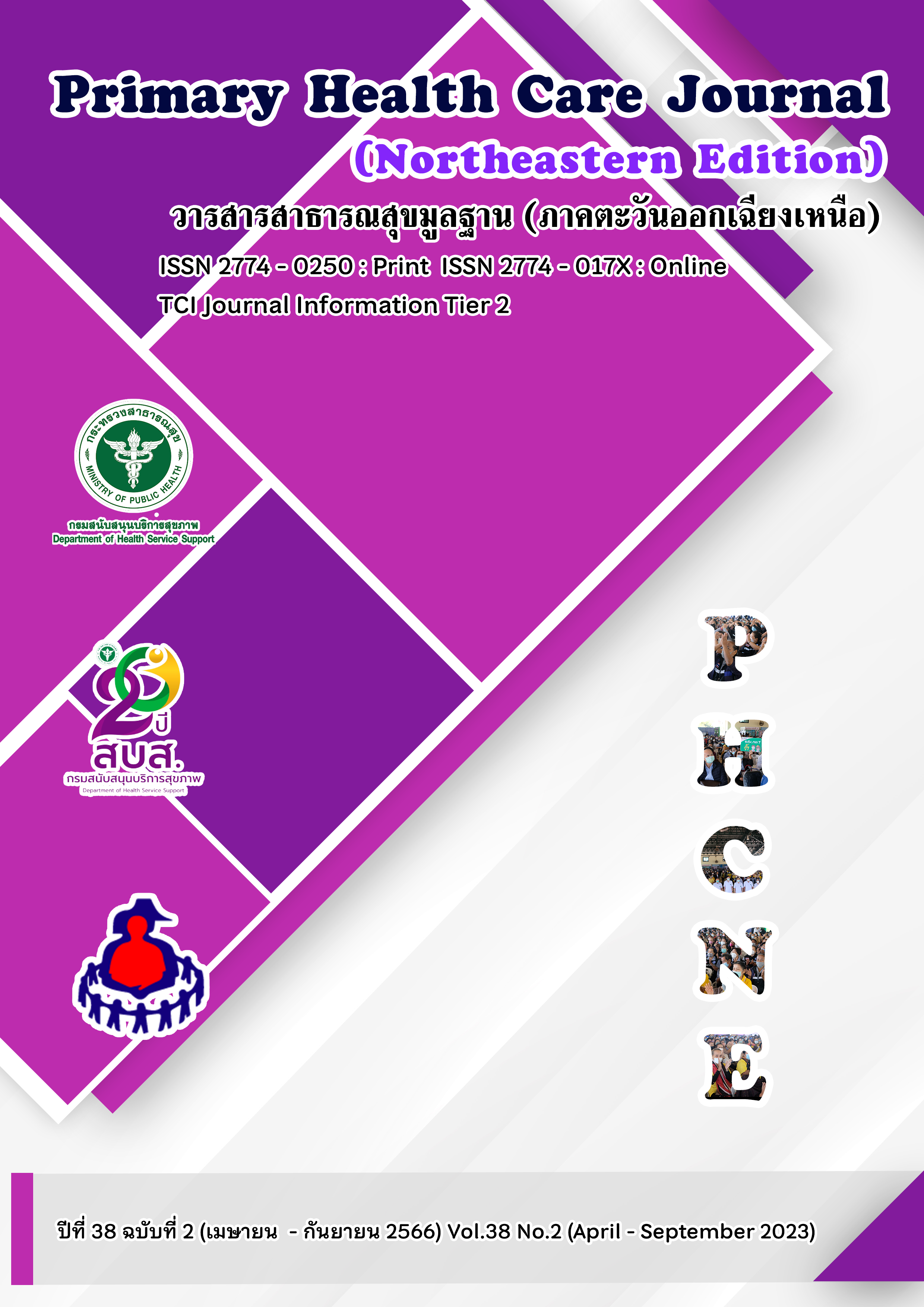THE DEVELOPMENT OF PATIENTS CARE WITH DRUG RESISTANT ORGANISMS IN CHUMPHON KHET UDOMSAKDI HOSPITAL
Keywords:
Development model, Drug resistant organism, Patient careAbstract
This research and development objective was to develop and study the effects of using a model of care patients with drug-resistant infections in Chumphon Khet Udomsakdi Hospital. Two groups of samples were 112 registered nurses, and a group of 150 patients were divided into a group of 75 patients who used a model of care patients with drug-resistant infections and a group of 75 patients who cared for patients with normal drug-resistant infections. Data was collected between May 2022 - May 2023. The research tools were the development plan for the care model for patients with drug-resistant infections, guidelines for prevention and control of the spread of drug-resistant infections, and collecting data with a practice record form, knowledge questionnaire, satisfaction questionnaire, and data record form for patients with drug-resistant infections. Data were analyzed by descriptive statistics, Paired t-test, Chi-square, McNemar x2, relative risk (RR) analysis, and qualitative data analysis by content analysis. The study found that the model of care for patients with drug-resistant infections consists of guidelines for the care of patients with drug-resistant infections. educating supervision and support of equipment and tools After using the format, the average knowledge score increased significantly at the.05 level, and the correctness of practice increased significantly at the.05 level. The registered nurses were satisfied with the model at a high level. The incidence of drug-resistant infections in the hospital decreased by about 0.42 times, the mortality rate decreased by about 0.38 times, and the cost of antimicrobial drugs and the number of hospitalization days decreased significantly at the.05 level. Conclusion: A model for caring for drug-resistant sepsis patients that is suitable for the context of the hospital. As a result, personnel have the knowledge to properly care for patients with drug-resistant infections. The incidence of drug-resistant infections in hospitals and death rates decreased. It is recommended that the agency have a policy to develop a form of care for patients with drug-resistant infections for personnel to increase work efficiency.
References
กรมการแพทย์ กระทรวงสาธารณสุข. (2565). คู่มือการประเมินการจัดการการดื้อยาต้านจุลชีพอย่างบูรณาการในโรงพยาบาล. (พิมพ์ครั้งที่ 1). กรุงเทพฯ : ห้างหุ้นส่วนจำกัด งานพิมพ์.
คณะกรรมการประสานและบูรณาการงานด้านการดื้อยาต้านจุลชีพ. (2560). แผนยุทธศาสตร์การจัดการการดื้อยาต้านจุลชีพประเทศไทย พ.ศ. 2560-2564. เข้าถึงได้จาก http://www.fda.moph.go.th/sites/drug/Shared%20Documents/AMR%20 (1 พฤษภาคม 2565)
ชลทิศ บุญร่วม, อะเคื้อ อุณหเลขกะ และวันชัย เลิศวัฒนวิลาศ. (2560). ปัจจัยทำนายการปฏิบัติการป้องกันการแพร่กระจายเชื้อดื้อยาของพยาบาลวิชาชีพในโรงพยาบาลศูนย์. พยาบาลสาร, 47(2), 133-142.
ชูศรี วงศ์รัตนะ. (2553). เทคนิคการใช้สถิติเพื่อการวิจัย. (พิมพ์ครั้งที่ 12). กรุงเทพฯ: ฐานบัณฑิต.
นาตยา ปริกัมศีล, ศุภา เพ็งเลา และสมใจ สายสม. (2561). ผลของการใช้โปรแกรมการพยาบาลผู้ป่วยติดเชื้อแบคทีเรียดื้อยาควบคุมพิเศษต่อความรู้และการปฏิบัติการพยาบาลผู้ป่วยติดเชื้อแบคทีเรียดื้อยาควบคุมพิเศษของบุคลากรสุขภาพผู้ป่วยหนักในโรงพยาบาลโพธาราม. วารสารหัวหินสุขใจไกลกังวล, 3(2), 49-57.
ประภัสสร เดชศรี, นงเยาว์ เกษตร์ภิบาล และนงค์คราญ วิเศษกุล. (2564). ผลของกลยุทธ์หลากหลายวิธีต่อความรู้และการปฏิบัติการป้องกันการแพร่กระจายเชื้อดื้อยาต้านจุลชีพหลายขนานในโรงพยาบาล หอผู้ป่วยกึ่งวิกฤตโรงพยาบาลศูนย์. พยาบาลสาร, 48(3), 154-166.
พรพิมล อรรถพรกุศล และคณะ. (2564). ผลลัพธ์ของการใช้แนวปฏิบัติการพยาบาลในการป้องกันและควบคุมการติดเชื้อดื้อยาต้านจุลชีพ โรงพยาบาลนพรัตนราชธานี. วารสารการพยาบาลและสุขภาพ สสอท., 3(3), 1-15.
โรงพยาบาลชุมพรเขตรอุดมศักดิ์. (2561). แนวทางปฏิบัติในการป้องกันและควบคุมการแพร่กระจายเชื้อดื้อยา 2561. คณะกรรมการป้องกันและควบคุมการติดเชื้อในโรงพยาบาล โรงพยาบาลชุมพรเขตรอุดมศักดิ์.
โรงพยาบาลชุมพรเขตรอุดมศักดิ์. (2564). รายงานการเฝ้าระวังการติดเชื้อในโรงพยาบาล 2562-2564. คณะกรรมการป้องกันและควบคุมการติดเชื้อในโรงพยาบาล โรงพยาบาลชุมพรเขตรอุดมศักดิ์.
โรงพยาบาลชุมพรเขตรอุดมศักดิ์. (2565). รายงานผลการตรวจทางห้องปฏิบัติการจุลชีววิทยา ตุลาคม 2564 -มีนาคม 2565. งานจุลชีววิทยาคลินิก. โรงพยาบาลชุมพรเขตรอุดมศักดิ์.
วิจิตย์ ทองแสน. (2564). การพัฒนารูปแบบการส่งเสริมการปฏิบัติการป้องกันการติดเชื้อดื้อยาของบุคลากรพยาบาล อำเภอโพนพิสัย จังหวัดหนองคาย. วารสารการพยาบาล สุขภาพ และการศึกษา, 4(1), 19-28.
วิไลลักษณ์ วงศ์จุลชาติ. (2560). การใช้กลวิธีหลากหลายเพื่อส่งเสริมการปฏิบัติตามแนวทางป้องกันและควบคุมการแพร่กระจายเชื้อดื้อยา ในโรงพยาบาลวชิระภูเก็ต. วารสารวิชาการแพทย์เขต 11, 31(3), 411-456.
วิษณุ ธรรมลิขิตกุล. (2560). โครงการควบคุมและป้องกันการดื้อยาต้านจุลชีพในประเทศไทย. (2560). สำนักงานกองทุนสนับสนุนการสร้างเสริมสุขภาพ (สสส.) สถาบันวิจัยระบบสาธารณสุข (สวรส.). เข้าถึงได้จาก https://kb.hsri.or.th/dspace/bitstream/handle/11228/4700/hs2339.pdf. (6 พฤษภาคม 2565)
สถาบันบำราศนราดูร. (2562). การป้องกันการติดเชื้อดื้อยาต้านจุลชีพในโรงพยาบาล. (พิมพ์ครั้งที่ 1). กรุงเทพมหานคร: อักษรกราฟฟิคแอนด์ดีไซน์.
สถาบันบำราศนราดูร. (2563). คู่มือปฏิบัติการป้องกันและควบคุมการติดเชื้อในโรงพยาบาล. (พิมพ์ครั้งที่ 1). กรุงเทพฯ: อักษรกราฟฟิคแอนด์ดีไซน์.
สถาบันบำราศนราดูร. (2564). การสำรวจการใช้ยาต้านจุลชีพในโรงพยาบาลของประเทศไทยโดยวิธี Point Prevalence Survey พ.ศ. 2564. นนทบุรี: สำนักงานพัฒนานโยบายสุขภาพระหว่างประเทศ กระทรวงสาธารณสุข.
สถาบันวิจัยวิทยาศาสตร์สาธารณสุข กรมวิทยาศาสตร์ การแพทย์. (2564). สถานการณ์ดื้อยาต้านจุลชีพปี 2020-2022. เข้าถึงได้จาก http://narst.dmsc.moph.go.th/data/AMR%202000-2020-12M.pdf. (6 พฤษภาคม 2565)
สมถวิล อัมพรอารีกุล และสมรักษ์ ศิริเขตรกรณ์. (2565). ผลของการใช้แนวทางปฏิบัติดูแลผู้ป่วยติดเชื้อดื้อยา สถาบันบำราศนราดูร. วารสารสถาบันบำราศนราดูร, 16(2), 60-71.
สมสมัย บุญส่อง, เปรมฤทัย น้อยหมื่นไวย และนุสรา ประเสริฐศรี. (2564). การพัฒนารูปแบบการนิเทศทางคลินิกเพื่อป้องกันการแพร่กระจายเชื้อแบคทีเรียดื้อยาในแผนกศัลยกรรมประสาท โรงพยาบาลสรรพสิทธิประสงค์. (วิทยานิพนธ์ปริญญาพยาบาลศาสตรมหาบัณฑิต สาขาวิชาการบริหารการพยาบาล) มหาวิทยาลัยสุโขทัยธรรมาธิราช.
อรุณ จิรวัฒน์กุล. (2548). ชีวสถิติสำรับงานวิจัยด้านวิทยาศาสตร์สุขภาพ. (พิมพ์ครั้งที่ 2). ขอนแก่น : ภาควิชาสถิติและประชากรศาสตร์ มหาวิทยาลัยขอนแก่น.
อรุณ จิรวัฒน์กุล. (2557). สถิติในงานวิจัย เลือกใช้อย่างไรให้เหมาะสม. (พิมพ์ครั้งที่ 1). กรุงเทพฯ: วิทยพัฒน์.
อะเคื้อ อุณหเลขกะ, สุชาดา เหลืองอาภาพงศ์ และจิตตาภรณ์ จิตรีเชื้อ. (2557). การป้องกันการติดเชื้อดื้อยาในหออภิบาลผู้ป่วย Prevention of Multidrug Resistant Organism Infections in Intensive Care Units. (รายงานการวิจัย). เชียงใหม่: คณะพยาบาลศาสตร์ มหาวิทยาลัย เชียงใหม่.
อะเคื้อ อุณหเลขกะ. (2561). แนวทางการป้องกันการแพร่กระจายเชื้อดื้อยาในโรงพยาบาล. (พิมพ์ครั้งที่ 4). เชียงใหม่ : บริษัทมิ่งเมืองนวรัตน์ จำกัด (โรงพิมพ์มิ่งเมือง).
อะเคื้อ อุณหเลขกะ. (2563). การประยุกต์ใช้วิธีการพัฒนาคุณภาพโดยความร่วมมือในการป้องกันการขาดยาของผู้ป่วยวัณโรคปอดรายใหม่. (รายงานการวิจัย). เชียงใหม่: คณะพยาบาลศาสตร์ มหาวิทยาลัยเชียงใหม่.
Abbara S. et al. (2019). Impact of a multimodal strategy combining a new standard of care and restriction of carbapenems, fluoroquinolones and cephalosporins on antibiotic consumption and resistance of Pseudomonas aeruginosa in a French intensive care unit. Int J Antimicrob Agents, 53(4), 416-422.
Bernard, R. (2000). Fundamentals of biostatistics. (5th ed). Duxbery: Thomson learning.
Center for Disease Control and Prevention. (2017). Management of multidrug-resistant organisms in healthcare settings, 2006. Retrieved from https://www.cdc.gov/infection control/ pdf/guidelines/mdro-guidelines.pdf (14 May 2022)
English, KM. et al. (2018). Contact among healthcare workers in the hospital setting: Developing the evidence base for innovative approaches to infection control. BMC Infection Disease, 18(1), 184. DOI:10.1186/s12879-018-3093-x
Giraldi, G. et al. (2019). Healthcare-associated infections due to multidrug-resistant organisms: A surveillance study on extra hospital stay and direct costs. Current Pharmaceutical Biotechnology, 20(8), 643-652.
Hansen, S. et al. (2010). Methicillin-resistant Staphylococcus aureus (MRSA) in Europe: which infection control measures are taken. Infection Control and Hospital Epidemiology, 38(3), 159-164.
Institute for Healthcare Improvement. (2003). The Breakthrough Series: IHI’s Collaborative model for achieving breakthrough improvement. Retrieved from http://www.ihi.org/NR/rdonlyres (2 May 2022)
Maslikowska, JA. et al. (2016). Impact of infection with extended-spectrum b-lactamase-producing Escherichia coli or Klebsiella species on outcome and hospitalization costs. Journal of Hospital Infection, 92(1), 33-41.
Naghavi M. (2022). Global burden of bacterial antimicrobial resistance in 2019: a systematic analysis. Lancet, 399, 629–655. doi.org/10.1016/S0140-6736(21)02724-0
Zhen, X. et al. (2020). Clinical and economic impact of methicillin-resistant Staphylococcus aureus: A multicenter study in China. Scientific Reports, 10, 3900.
Downloads
Published
How to Cite
Issue
Section
License
Copyright (c) 2023 ศูนย์พัฒนาการสาธารณสุขมูลฐาน ภาคตะวันออกเฉียงเหนือ จังหวัดขอนแก่น กรมสนับสนุนบริการสุขภาพ กระทรวงสาธารณสุข

This work is licensed under a Creative Commons Attribution-NonCommercial-NoDerivatives 4.0 International License.




